

How to do Close Reading-Procedure. Why It's Time To Change How Students Cite Their Work. When students write a paper, it goes without saying that they must cite the sources that they use in creating it.

For generations, students have created note cards to document and organize these resources and/or submitted a bibliography page with their finished work. In the modern classroom, student research and creation has taken on a new look. Before, when students created a poster, and then separately handed in a bibliography page to the teacher, justice was done and fair credit was given for the ideas used. However, as widespread sharing of these projects becomes more common, and the internet allows students to reach an audience far beyond the school or classroom, we need to re-evaluate this procedure and address our responsibility to share these sources – not just with the teacher or school, but with all who might consume the project.
Without readily available sources to review, the audience cannot truly evaluate the validity of the project. 1. CCSS Cite Evidence. Argument theories. 6 Free Online Resources for Primary Source Documents. The Common Core Learning Standards describe the importance of teaching students how to comprehend informational text.

They are asked to read closely, make inferences, cite evidence, analyze arguments and interpret words and phrases as they are used in a text. Primary source documents are artifacts created by individuals during a particular period in history. This could be a letter, speech, photograph or journal entry. If you're looking to integrate social studies into your literacy block, try out one of these resources for primary source documents. 1. The National Archives is a fantastic resource. 2. Also run by the National Archives, DocsTeach is full of activities for educators. 3. Spartacus Educational is a great resource for global history. 4. Fordham University is another good resource for global history. 5. Broken down by time period then listed in alphabetical order, the Avalon Project at Yale University also has primary sources for global history teachers.
Ela-teach-strat-read-text-6-12.pdf. Looking at Complex Texts More Complexly (or What’s Wrong with this Picture?) By now many of us have experienced or heard about the effects of using Lexile levels as the sole arbiter of text complexity.
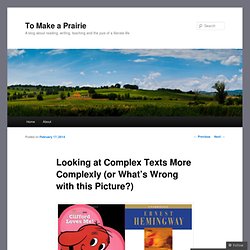
In her wonderful post “Guess My Lexile,” for instance, Donalyn Miller looks at the absurdity of putting book with widely different reader appeal and age appropriateness in the same book bin because they share a Lexile level (as my own favorite Lexile odd couple, Clifford and Hemingway, do, with both clocking in at 610L). 15 Books That Will Make You A Better Teacher. Top 10 Things Picture Books Taught Me by Beth Shaum. What “counts” as reading?
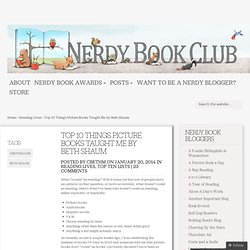
Well it turns out that lots of people have an opinion on that question, or more accurately, what doesn’t count as reading. Here’s what I’ve been told doesn’t count as reading, either explicitly or implicitly: Picture booksAudiobooksGraphic novelsYA litChoice reading in classAnything other than the canon of old, dead white guysAnything a kid might actually enjoy As recently as just a couple weeks ago, I was celebrating the number of books I’d read in 2013 and someone told me that picture books don’t “count” as books. Argument writing. Socratic Seminar. Writing about Reading: A Quick Guide to Quick Literary Essays. For years, I taught the unit Literary Essays: Writing about Reading in Lucy Calkins’s previous Writing Units of Study, co-written with Medea Mcevoy (2006).
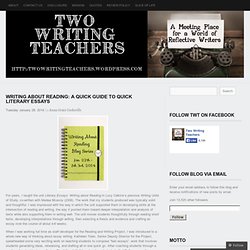
The work that my students produced was typically solid and thoughtful. I was impressed with the way in which the unit supported them in developing skills at the intersection of reading and writing, the way it pushed them toward deeper interpretation and analysis of texts while also supporting them in writing well. Your Core Companion: Just What IS “Close Reading”?
Articles of the Week (AoW) Cause and Effect. Heroes of History. One popular conversation in education centers around "What is worth knowing?
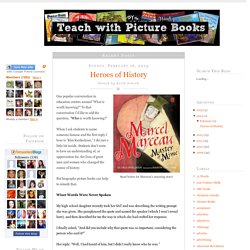
" The History 2.0 Classroom. Let's Chat Core: Simplifying Text Complexity. As I meet and talk to teachers about the Common Core State Standards, I consistently hear the question: “What is all this text complexity?
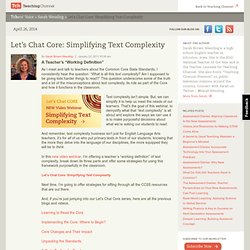
Am I supposed to be giving kids harder things to read?” This question underscores some of the truth and a lot of the misconceptions about text complexity, its role as part of the Core and how it functions in the classroom. Text complexity isn’t simple. Close Reading. Five close reading strategies to support the Common Core. I walked in to my first college class, Political Science 101, eager to learn.

For my inaugural college assignment, my professor asked the class to read the first three chapters of the textbook for the next class period. Informational Text Resources. Literary Non-Fiction. How to do a Close Reading Video. Close Reading Resources. Sample Units. Sample Units For our first volume, Using Informational Text to Teach To Kill a Mockingbird, there was so much great stuff, we couldn’t fit it all into the book! It was tough to pick two chapters to leave out of the print version, but we had to cut the volume in size or face an unreasonable sales price.
The good news is we can share these materials with you immediately online. Teacher Read-Aloud That Models Reading for Deep Understanding. Research Basis Strategy in Practice Related Resources Teacher read-alouds demonstrate the power of stories.
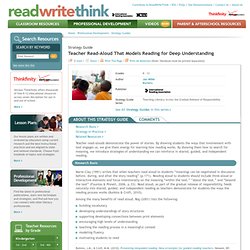
By showing students the ways that involvement with text engages us, we give them energy for learning how reading works. By showing them how to search for meaning, we introduce strategies of understanding we can reinforce in shared, guided, and independent reading.